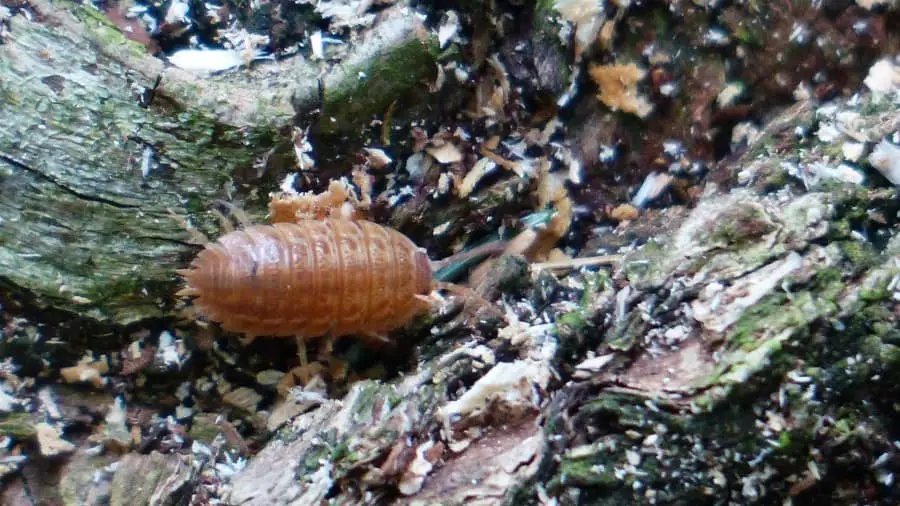
Isopods look like a delicious snack that chameleons can eat at any time of the day. It’s been said by many that by keeping a variety of foods in your chameleon’s diet, you will keep them invested in eating them. This means that adding isopods to their diets is a good idea right? Can chameleons eat isopods though?
Chameleons are perfectly fine eating isopods. Isopods are a great addition to chameleons’ diet as they have some benefits. Adding isopods to their diet is a great way to keep your chameleon interested in eating.
Many people seem to glance over isopods when it comes to food choices for their reptiles in general. There are many species of isopods living in the wild.
You can bet that wild chameleons have eaten isopods during one of their many hunts. So what are the benefits your chameleon can get by eating isopods?
What Are The Benefits of Chameleons Eating Isopods?
Like many foods, isopods hold a great deal of nutritional value for your chameleon. They are by no means a replacement for the staple food but they are a great snack every now and then.
Use isopods to supplement your chameleon’s diet for whatever they are lacking in. Here are some of the benefits your chameleon can get from being fed isopods.
Calcium
Isopods are incredibly high in calcium. This is because they have a shell that acts as their skeleton and protects them from external harm. This shell is made up of mostly calcium, just like how eggshells are formed.
Calcium is an essential mineral for chameleons. They help to strengthen bones and many other basic bodily functions. Calcium is especially important for chameleons because of the way they store it.
For humans and most animals, the calcium in our body is stored in our bones and teeth. However for chameleons though, their calcium storages are mostly in the largest organ of their body, the skin.
Chameleons shed every one or two months to keep their skin healthy and clean. This process, as beneficial as it is, makes them lose a significant amount of calcium in their body when done.
This is why it isn’t surprising to see a chameleon eat its own shedding to replenish its calcium. Of course, this is only one of many reasons why chameleons eat their own shedding.
Phosphorus
Second, only to calcium as the most abundant mineral found in the body, phosphorus is also important for chameleons. Phosphorus is needed for many functions such as filtering waste, repairing tissues and cells, and maintaining bone health and strength.
Soil-dwelling isopods like pill bugs, have twelve times the amount of phosphorus in them when compared to other live feed. This can help balance out the phosphorus levels in chameleons naturally if fed correctly.
Additional Nutrition
The best part about isopods has to be the fact that they will eat anything you throw at them and I do mean everything. Bugs are known to absorb most of what they eat and this can help transfer over to your chameleon.
Not only are they supplemental by themselves, but you can also use them to further supplement your chameleon with the nutrition that they need by feeding the bugs with the proper nutrition.
Feeding the isopods a rich and varied diet before feeding them to your chameleon will improve their value as food exponentially. It can’t all just be upsides and there have to be a few downsides right?
The Problems of Feeding Isopods to Chameleons
Nothing in the world is just sunshine and rainbows. Isopods aren’t just all benefits, they come with a few problems as well. Here are the problems you might face when feeding your chameleon isopods.
Chitin
Chitin is an undigestable substance and one of the hardest material that is producible by biological means. Isopods are covered in this powerful armor and this might prove to be a problem to your chameleon.
However, chitin isn’t entirely undigestable as it can be processed by symbiotic bacteria and protozoa which can be found in the stomach of some insects. Conveniently, a chameleon’s diet is mostly made up of insects.
It won’t be a problem for your chameleon to digest chitin if they stick to their regular diet of insects. Just make sure that chitin isn’t the main part of your chameleon’s diet and it’ll be fine.
Phosphorus (Again)
Seems weird that phosphorus would appear as both an upside and a downside but surprisingly it isn’t. As we have established, isopods are packed full of phosphorus with their content higher than most other live feed in a chameleon’s diet.
This is beneficial to their health of course but it becomes a problem if they have too much of it. With such a high amount of phosphorus, it is very easy to overdose a chameleon with it when feeding it isopods.
High amounts of phosphorus may cause digestion problems, organ hardening, and soft tissue in a chameleon. Not only that, but it inhibits the body’s ability to use other minerals such as iron, calcium, magnesium, and zinc.
Phosphorus can also combine with calcium and cause mineral deposits in the muscles. This will slow down your chameleon’s movements and even cause them pain as the deposits grow too large. This is why it is important that you feed your chameleon isopods properly.
Can Isopods Be A Staple Food In A Chameleon’s Diet?
Isopods were never meant to be a staple food. They are always and only considered to be a treat and there is a good reason for that.
Other than the fact that they might overdose your chameleon with phosphorus, and the fact that they are covered in chitin, they are also full of ash.
Ash can stick to the walls in their bodies and accumulate as large masses which will eventually inhibit bodily functions in some way. There is also a high possibility of choking your chameleon which causes them to die.
How Often Should I Feed My Chameleon Isopods?
It varies from chameleon to chameleon because personal preference is still a thing. Some chameleons may like to be fed isopods often while others don’t, so there is no definite answer.
The general guideline is to feed them isopods every now and again. This will not only ensures that you are giving them a safe amount, but it also spices up their diet by adding variety in it, preventing them from getting fed up from eating.
Just keep in mind that isopods are nothing more than a treat and your chameleon will be fine.
How Do I Store & Breed Isopods To Feed My Chameleon?
One of the many problems with feeding your chameleon isopods is the availability of it. Most chameleon owners seem to find it difficult to find a pet store that sells isopods.
A lot of times, this discourages them from adding isopods into the diet of their chameleons. Little did they know that it is actually possible to store and breed them all in the convenience of your own home.
Isopods don’t require much to be able to live and reproduce. All you have to do is keep a colony of them in a ventilated plastic container big enough for them to move around.
A substrate is needed as well. Anywhere between 3 to 4 inches of the substrate is enough for them to create a home. Keep the substrate moist enough but not soaking wet so that you don’t drown the isopods.
You can feed them with almost anything as long as it is edible and beneficial enough to transfer to your chameleon. A cool place is needed for them to thrive.
Any place that is cool is ideal but average room temperatures will work just fine. Keep an eye on the moisture level of the terrarium so that your isopods don’t dry out and die before you can feed them to your chameleon.
A nice and well-kept isopod colony will supply your chameleon with a huge number of isopods of varying sizes.
Can I Feed My Chameleon Dried Isopods?
Technically, your chameleon won’t have any problems eating dried isopods. The issue lies within the worth of it. Dried isopods lose not only all of their water, but also most of their nutrition as well.
If this snack proves to have no nutritional value in them, then what is the point of feeding them to your chameleon?
Personally, I would stray from feeding your chameleon any dried isopods, live ones are simply the better ones.
Can I Feed My Chameleon Dead Isopods?
Dead isopods should never be considered as live feed for your chameleon. First of all, just like dried isopods, they lose a lot of their nutritional value.
Second of all, you have no idea how the isopod died. It may have died to disease, or a microorganism attack, which will then transfer over to your chameleon.
This is no different than sending your chameleon to their death. I recommend straying away from feeding dead isopods even if you know how they died, better to be safe than sorry.
Conclusion
Isopods are a great snack to include to spice up your chameleon’s diet plans. They contain a few benefits that can help improve your chameleon’s quality of life, something every pet owner wants for their pets.
However, there are a few problems with isopods and one of them even comes from a benefit they have. Feed them in moderation to avoid complications that might arise.
Isopods are never a staple food in a chameleon’s diet. They are only meant as a snack and it should stay that way else the risk of malnutrition.
If you find it hard to find live isopods to feed your chameleon, consider making a colony. This way, not only can you store the isopods for your chameleon, but also breed them as much as you want to constantly supply your chameleon.
Even if for some reason you can’t breed isopods, never take dried or dead isopods as an alternative. They would have already lost most of the nutritional value and who knows what kind of problems they bring which will then transfer over to your chameleon.
I don’t think you would want that to happen. Would you look at the time, it’s time to feed my chameleon again. Let me treat it with some isopods as a good ol’ snack.

